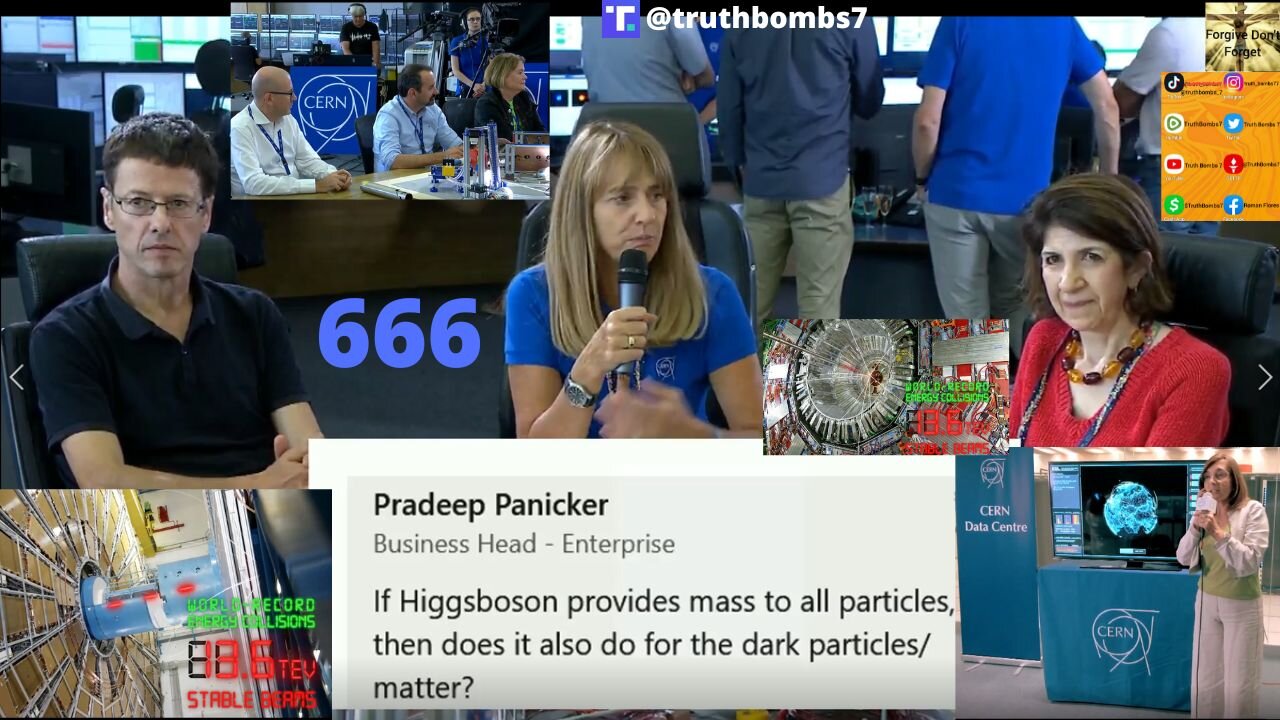Premium Only Content

7/5/2022 LIVE CERN (LHC)Activation Q&A "Dark Matter Data Portal", "Satan's Great Deception Data"
Like, Share, Subscribe To Video Rumble Link: Channel “TruthBombs7”
https://rumble.com/v1akiz8-6302022-enemy-blank-rounds-left-meltdowns-ghislaine-sentenced-huge-week.html
$Cash App Handle: $TruthBombs7
YouTube Channel Link: https://www.youtube.com/channel/UCniWeo7aiSNCjVq3oVqu_Ig
Twitter Channel Link:
https://twitter.com/fl40183965/status/1521645014341857281?t=hivRqG5WhykdUeq2NK5ajw&s=19
Gettr Channel Link:
https://gettr.com/post/p18tv4bf055
Truth Social Handle: https://truthsocial.com/@truthbombs7
@truthbombs7
Tic Tok Handle:
https://www.tiktok.com/@truthbombs_7?is_from_webapp=1&sender_device=pc
Instagram Handle:
https://www.instagram.com/truth_bombs77/
The European Organization for Nuclear Research (French: Organisation européenne pour la recherche nucléaire), known as CERN (/sɜːrn/; French pronunciation: [sɛʁn]; derived from the name Conseil européen pour la recherche nucléaire), is a European research organization that operates the largest particle physics laboratory in the world. Established in 1954, the organization is based in a northwest suburb of Geneva on the Franco–Swiss border and has 23 member states.[3] Israel is the only non-European country granted full membership.[4] CERN is an official United Nations Observer.[5]
The acronym CERN is also used to refer to the laboratory, which in 2019 had 2,660 scientific, technical, and administrative staff members, and hosted about 12,400 users from institutions in more than 70 countries.[6] In 2016 CERN generated 49 petabytes of data.[7]
CERN's main function is to provide the particle accelerators and other infrastructure needed for high-energy physics research – as a result, numerous experiments have been constructed at CERN through international collaborations. CERN is the site of the Large Hadron Collider (LHC), the world's largest and highest-energy particle collider.[8] The main site at Meyrin hosts a large computing facility, which is primarily used to store and analyse data from experiments, as well as simulate events. Researchers need remote access to these facilities, so the lab has historically been a major wide area network hub. CERN is also the birthplace of the World Wide Web.[9][10]
CERN operates a network of seven accelerators and two decelerators, and some additional small accelerators. Each machine in the chain increases the energy of particle beams before delivering them to experiments or to the next more powerful accelerator (the decelerators naturally decrease the energy of particle beams before delivering them to experiments or further accelerators/decelerators). Currently (as of 2022) active machines are the LHC accelerator and:
The LINAC 3 linear accelerator generating low energy particles. It provides heavy ions at 4.2 MeV/u for injection into the Low Energy Ion Ring (LEIR).[44]
The Low Energy Ion Ring (LEIR) accelerates the ions from the ion linear accelerator LINAC 3, before transferring them to the Proton Synchrotron (PS). This accelerator was commissioned in 2005, after having been reconfigured from the previous Low Energy Antiproton Ring (LEAR).[45][46]
The Linac4 linear accelerator accelerates negative hydrogen ions to an energy of 160 MeV. The ions are then injected to the Proton Synchrotron Booster (PSB) where both electrons are then stripped from each of the hydrogen ions and thus only the nucleus containing one proton remains. The protons are then used in experiments or accelerated further in other CERN accelerators. Linac4 serves as the source of all proton beams for CERN experiments.[47]
The Proton Synchrotron Booster increases the energy of particles generated by the proton linear accelerator before they are transferred to the other accelerators.[48]
The 28 GeV Proton Synchrotron (PS), built during 1954—1959 and still operating as a feeder to the more powerful SPS and to many of CERN's experiments.[49]
The Super Proton Synchrotron (SPS), a circular accelerator with a diameter of 2 kilometres built in a tunnel, which started operation in 1976. It was designed to deliver an energy of 300 GeV and was gradually upgraded to 450 GeV. As well as having its own beamlines for fixed-target experiments (currently COMPASS and NA62), it has been operated as a proton–antiproton collider (the SppS collider), and for accelerating high energy electrons and positrons which were injected into the Large Electron–Positron Collider (LEP). Since 2008, it has been used to inject protons and heavy ions into the Large Hadron Collider (LHC).[50][51][52]
The On-Line Isotope Mass Separator (ISOLDE), which is used to study unstable nuclei. The radioactive ions are produced by the impact of protons at an energy of 1.0–1.4 GeV from the Proton Synchrotron Booster. It was first commissioned in 1967 and was rebuilt with major upgrades in 1974 and 1992.[53]
The Antiproton Decelerator (AD), which reduces the velocity of antiprotons to about 10% of the speed of light for research of antimatter.[54] The AD machine was reconfigured from the previous Antiproton Collector (AC) machine.[55]
The Extra Low Energy Antiproton ring (ELENA), which takes antiprotons from AD and decelerates them into low energies (speeds) for use in antimatter experiments.
The AWAKE experiment, which is a proof-of-principle plasma wakefield accelerator.[56][57]
The CERN Linear Electron Accelerator for Research (CLEAR) accelerator research and development facility.[58][59]
Large Hadron Collider
Main article: Large Hadron Collider
Many activities at CERN currently involve operating the Large Hadron Collider (LHC) and the experiments for it. The LHC represents a large-scale, worldwide scientific cooperation project.[60]
CMS detector for LHC
The LHC tunnel is located 100 metres underground, in the region between the Geneva International Airport and the nearby Jura mountains. The majority of its length is on the French side of the border. It uses the 27 km circumference circular tunnel previously occupied by the Large Electron–Positron Collider (LEP), which was shut down in November 2000. CERN's existing PS/SPS accelerator complexes are used to pre-accelerate protons and lead ions which are then injected into the LHC.
Eight experiments (CMS,[61] ATLAS,[62] LHCb,[63] MoEDAL,[64] TOTEM,[65] LHCf,[66] FASER[67] and ALICE[68]) are located along the collider; each of them studies particle collisions from a different aspect, and with different technologies. Construction for these experiments required an extraordinary engineering effort. For example, a special crane was rented from Belgium to lower pieces of the CMS detector into its cavern, since each piece weighed nearly 2,000 tons. The first of the approximately 5,000 magnets necessary for construction was lowered down a special shaft at 13:00 GMT on 7 March 2005.
The LHC has begun to generate vast quantities of data, which CERN streams to laboratories around the world for distributed processing (making use of a specialized grid infrastructure, the LHC Computing Grid). During April 2005, a trial successfully streamed 600 MB/s to seven different sites across the world.
The initial particle beams were injected into the LHC August 2008.[69] The first beam was circulated through the entire LHC on 10 September 2008,[70] but the system failed 10 days later because of a faulty magnet connection, and it was stopped for repairs on 19 September 2008.
The LHC resumed operation on 20 November 2009 by successfully circulating two beams, each with an energy of 3.5 teraelectronvolts (TeV). The challenge for the engineers was then to try to line up the two beams so that they smashed into each other. This is like "firing two needles across the Atlantic and getting them to hit each other" according to Steve Myers, director for accelerators and technology.
On 30 March 2010, the LHC successfully collided two proton beams with 3.5 TeV of energy per proton, resulting in a 7 TeV collision energy. However, this was just the start of what was needed for the expected discovery of the Higgs boson. When the 7 TeV experimental period ended, the LHC revved to 8 TeV (4 TeV per proton) starting March 2012, and soon began particle collisions at that energy. In July 2012, CERN scientists announced the discovery of a new sub-atomic particle that was later confirmed to be the Higgs boson.[71] In March 2013, CERN announced that the measurements performed on the newly found particle allowed it to conclude that this is a Higgs boson.[72] In early 2013, the LHC was deactivated for a two-year maintenance period, to strengthen the electrical connections between magnets inside the accelerator and for other upgrades.
On 5 April 2015, after two years of maintenance and consolidation, the LHC restarted for a second run. The first ramp to the record-breaking energy of 6.5 TeV was performed on 10 April 2015.[73][74] In 2016, the design collision rate was exceeded for the first time.[75] A second two-year period of shutdown begun at the end of 2018.[76][77]
Accelerators under construction
As of October 2019, the construction is on-going to upgrade the LHC's luminosity in a project called High Luminosity LHC (HL-LHC). This project should see the LHC accelerator upgraded by 2026 to an order of magnitude higher luminosity.[78]
As part of the HL-LHC upgrade project, also other CERN accelerators and their subsystems are receiving upgrades. Among other work, the LINAC 2 linear accelerator injector was decommissioned and replaced by a new injector accelerator, the LINAC4.[79]
Decommissioned accelerators
The original linear accelerator LINAC 1. Operated 1959–1992.[80]
The LINAC 2 linear accelerator injector. Accelerated protons to 50 MeV for injection into the Proton Synchrotron Booster (PSB). Operated 1978–2018.[81]
The 600 MeV Synchro-Cyclotron (SC) which started operation in 1957 and was shut down in 1991. Was made into a public exhibition in 2012–2013.[82][83]
The Intersecting Storage Rings (ISR), an early collider built from 1966 to 1971 and operated until 1984.[84][85]
The Super Proton–Antiproton Synchrotron (SppS), operated 1981–1991.[86] A modification of Super Proton Synchroton (SPS) to operate as a proton-antiproton collider.
The Large Electron–Positron Collider (LEP), which operated from 1989 to 2000 and was the largest machine of its kind, housed in a 27 km-long circular tunnel which now houses the Large Hadron Collider.[87][88]
The LEP Pre-Injector (LPI) accelerator complex,[89] consisting of two accelerators, a linear accelerator called LEP Injector Linac (LIL; itself consisting of two back-to-back linear accelerators called LIL V and LIL W) and a circular accelerator called Electron Positron Accumulator (EPA).[90] The purpose of these accelerators was to inject positron and electron beams into the CERN accelerator complex (more precisely, to the Proton Synchrotron), to be delivered to LEP after many stages of acceleration. Operational 1987–2001; after the shutdown of LEP and the completion of experiments that were directly feed by the LPI, the LPI facility was adapted to be used for the CLIC Test Facility 3 (CTF3).[91]
The Low Energy Antiproton Ring (LEAR) was commissioned in 1982. LEAR assembled the first pieces of true antimatter, in 1995, consisting of nine atoms of antihydrogen.[92] It was closed in 1996, and superseded by the Antiproton Decelerator. The LEAR apparatus itself was reconfigured into the Low Energy Ion Ring (LEIR) ion booster.[45]
The Antiproton Accumulator (AA), built 1979–1980, operations ended in 1997 and the machine was dismantled. Stored antiprotons produced by the Proton Synchrotron (PS) for use in other experiments and accelerators (for example the ISR, SppS and LEAR). For later half of its working life operated in tandem with Antiproton Collector (AC), to form the Antiproton Accumulation Complex (AAC).[93]
The Antiproton Collector (AC),[94][95] built 1986–1987, operations ended in 1997 and the machine was converted into the Antiproton Decelerator (AD), which is the successor machine for Low Energy Antiproton Ring (LEAR). Operated in tandem with Antiproton Accumulator (AA) and the pair formed the Antiproton Accumulation Complex (AAC),[93] whose purpose was to store antiprotons produced by the Proton Synchrotron (PS) for use in other experiments and accelerators, like the Low Energy Antiproton Ring (LEAR) and Super Proton–Antiproton Synchrotron (SppS).
The Compact Linear Collider Test Facility 3 (CTF3), which studied feasibility for the future normal conducting linear collider project (the CLIC collider). In operation 2001–2016.[91] One of its beamlines has been converted, from 2017 on, into the new CERN Linear Electron Accelerator for Research (CLEAR) facility.
Possible future accelerators
Main article: Future Circular Collider
CERN, in collaboration with groups worldwide, is investigating two main concepts for future accelerators: A linear electron-positron collider with a new acceleration concept to increase the energy (CLIC) and a larger version of the LHC, a project currently named Future Circular Collider.[96]
Sites
Interior of office building 40 at the Meyrin site. Building 40 hosts many offices for scientists from the CMS and ATLAS collaborations.
The smaller accelerators are on the main Meyrin site (also known as the West Area), which was originally built in Switzerland alongside the French border, but has been extended to span the border since 1965. The French side is under Swiss jurisdiction and there is no obvious border within the site, apart from a line of marker stones.
The SPS and LEP/LHC tunnels are almost entirely outside the main site, and are mostly buried under French farmland and invisible from the surface. However, they have surface sites at various points around them, either as the location of buildings associated with experiments or other facilities needed to operate the colliders such as cryogenic plants and access shafts. The experiments are located at the same underground level as the tunnels at these sites.
Three of these experimental sites are in France, with ATLAS in Switzerland, although some of the ancillary cryogenic and access sites are in Switzerland. The largest of the experimental sites is the Prévessin site, also known as the North Area, which is the target station for non-collider experiments on the SPS accelerator. Other sites are the ones which were used for the UA1, UA2 and the LEP experiments (the latter are used by LHC experiments).
Outside of the LEP and LHC experiments, most are officially named and numbered after the site where they were located. For example, NA32 was an experiment looking at the production of so-called "charmed" particles and located at the Prévessin (North Area) site while WA22 used the Big European Bubble Chamber (BEBC) at the Meyrin (West Area) site to examine neutrino interactions. The UA1 and UA2 experiments were considered to be in the Underground Area, i.e. situated underground at sites on the SPS accelerator.
Most of the roads on the CERN Meyrin and Prévessin sites are named after famous physicists, such as Wolfgang Pauli, who pushed for CERN's creation. Other notable names are Richard Feynman, Albert Einstein, and Bohr.
Participation and funding
Member states and budget
Since its foundation by 12 members in 1954, CERN regularly accepted new members. All new members have remained in the organization continuously since their accession, except Spain and Yugoslavia. Spain first joined CERN in 1961, withdrew in 1969, and rejoined in 1983. Yugoslavia was a founding member of CERN but quit in 1961. Of the 23 members, Israel joined CERN as a full member on 6 January 2014,[97] becoming the first (and currently only) non-European full member.[98]
The budget contributions of member states are computed based on their GDP.[99]
-
 41:14
41:14
The White House
5 hours agoPresident Trump Greets and Welcomes Marc Fogel Back to The United States
74.6K33 -
 6:48:41
6:48:41
Akademiks
7 hours agoKendrick Lamar performs at the Superbowl. Does NOT LIKE US. Now projected to sell 230K! Drake done?
131K14 -
 5:12:34
5:12:34
MyronGainesX
9 hours ago $28.40 earnedChat With Pearl, Tucker vs Piers, Shopify Cancels Ye, FBI leaks ICE Raids, Trump On Jordan & Gaza!
87.8K20 -
 1:33:07
1:33:07
Man in America
16 hours ago🚨 Chlorine Dioxide: Banned, Censored & Feared by Big Pharma w/ Jonathan Otto
45.6K51 -
 9:21
9:21
Colion Noir
6 hours agoMan Robbed Carrying Gun In Back Pocket, Then Shot Trying To Get It Back
34K16 -
 2:00:39
2:00:39
DLDAfterDark
5 hours ago $6.48 earnedAnderson American Big Bore pistol Contest!
66K5 -
 2:02:20
2:02:20
Flyover Conservatives
1 day agoBiohacking Your Health: The Future of Medicine & Longevity - Part 2 - Deep Dive: Drs. Mark and Michele Sherwood | FOC Show
77.3K2 -
 1:27:30
1:27:30
AlaskanBallistics
5 hours ago $1.11 earnedI Love This Gun PodCast #7
42.3K2 -
 1:04:49
1:04:49
Glenn Greenwald
10 hours agoHow is Trump's Fixation on Taking Over Gaza "America First"?; Netanyahu Never Intended to Carry Through on Ceasefire Deal | SYSTEM UPDATE #405
96K116 -
 1:00:06
1:00:06
Rumble Rundown
17 hours agoThe Rumble Rundown: Rumble Studio and Creator Program
87.5K37